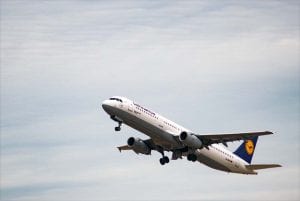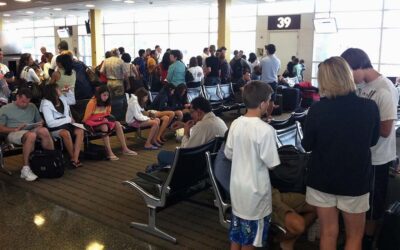The most common passenger in-flight medical emergency is passing out on planes
 When a flight attendant calls for a doctor in mid-flight, chances are a passenger has passed out on a plane. This is the most common in-flight medical emergency. The medical term is syncope — a temporary loss of consciousness usually related to insufficient blood flow to the brain. It is also called fainting or “passing out.”
When a flight attendant calls for a doctor in mid-flight, chances are a passenger has passed out on a plane. This is the most common in-flight medical emergency. The medical term is syncope — a temporary loss of consciousness usually related to insufficient blood flow to the brain. It is also called fainting or “passing out.”
I know about passing out on planes first-hand. I’ve fainted on planes three times, most recently aboard a DC-Munich flight in December. Now I’m “woke” to the growing issue of passing out on planes. I take it seriously. So should the Department of Transportation and the FAA, who have their heads in the sand as far as medical issues go with crowding more and more passengers on planes.
Flight attendants know that passing out on planes is pretty common.
A recent article in the LA Times highlighted the same problem that I faced aboard my flight to Munich.
On long-haul flights of six hours or more, it’s not unusual for at least one passenger to lose consciousness.
During my 30-year career as a flight attendant, no fewer than 300 passengers have passed out while I was on duty. (This is a conservative estimate based on about one fainting victim a month for the last three decades.)
People faint for a variety of reasons, including dehydration, irregular heart beat, low blood sugar, hyperventilation, a sudden drop in blood pressure, standing up and, of course, drinking alcohol, according to WebMD.com. On an airplane, where air circulation is notoriously poor, the lack of oxygen to the brain because of high cabin pressure can exacerbate the problem. Warm cabin air can make matters worse, which is partly why the temperature in an airplane cabin is often set to an uncomfortably cold level.
Fainting episodes follow a similar pattern
 All my passing out on planes scenarios were identical – a long-haul flight, uncomfortably warm cabin temperature, mid-flight nausea, lurching toward the galley for help, fainting on route, vomiting, confusion.
All my passing out on planes scenarios were identical – a long-haul flight, uncomfortably warm cabin temperature, mid-flight nausea, lurching toward the galley for help, fainting on route, vomiting, confusion.
On the flight to Munich, the Lufthansa cabin staff clearly knew the drill. They immediately got me horizontal, elevated my feet and cleaned me up. Soon I had two doctors at my side, an Emergency-room specialist administering oxygen, and a General Practitioner checking my vitals. Monica, the angelic GP, gave me a change of clothes from her own carry-on to replace my vomit-soaked T-shirt and tights.
“Why does this happen to me?” I asked woozily. “It’s a vasovagal episode,” said the ER doc. “You’ll be fine.” He explained a number of factors that contribute to fainting: insufficient oxygen (hypoxia) due to cabin pressure, immobility, a drop in blood pressure, and possible dehydration. Plus, the Airbus plane that carried me to Germany had no individual ventilation.
Crowded planes leave doctors with no room to treat ill passengers
With no empty seats available, I spent two hours lying on the floor by the rear exit door. The cold comfort of the galley floor was an improvement over my cramped economy seat row, where I’d been wedged in with my backpack and two large men in the adjoining seats. After I recovered, a flight attendant plied me with Coca-Cola and led me back to my seat. By the time I reached Munich, I was fine and caught a connecting flight to Poland.
Back home, I did some research and paid a visit to my doctor to figure out how to avoid fainting next time I fly. All my medical tests checked out normally, so I turned to on-line searches, which reaped a heap of references and personal testimonies of passengers like myself.
Flight attendants can attest to problem of passengers fainting
One flight attendant, who was also a registered nurse, quoted on www.airliner.net, confirmed that fainting is very common. “Basically, it occurs when you have been sitting for a long period and your blood concentrates in the lower extremities,” she wrote. “You start to feel dizzy, nauseous and so you try to head for the lav. Virtually all of the fainting, 99 percent, occurs right outside the lav. Once your body goes horizontal blood flows equally throughout and you wake up. I’ve seen it more on long haul flights …”
On-line publication Aviation Health noted that “passengers on long-haul flights who are seated at the rear of aircraft like the Airbus 340 and Boeing 767 seemed more likely to experience dizziness that usually resulted in fainting.
This temporary loss of consciousness through deficient blood supply to the brain can occur after a meal and/or when a passenger rises after prolonged sitting. An additional factor is oxygen deficiency of the cabin, whereby a small drop in blood pressure may have a significant effect on cerebral function. Alcohol, too, raises the blood flow to the intestines and the heart rate.” (aviation-health.co.uk)
Inflight medical issues are an increasing problem
I suspected that in-flight fainting could be a growing trend. Shrinking seat size and legroom coupled with reduced in-flight mobility might play a role. I searched for statistics. A study of 11,920 in-flight medical emergency calls reported by five domestic and international airlines from January 1, 2008, through October 31, 2010, found that syncope or presyncope accounted for 37.4 percent of cases (John Riefler, MD, Consultant360.com).
The medical profession’s page on Lufthansa’s website reports that the IATA Medical Advisory Group has recorded an increase in recent years of on-board medical incidents. Lufthansa has also noted an increase. The airline reported that it records 10 to 15 medical incidents every day on its 1,700 flights. That means 17,000 to 25,500 faintings per day on only Lufthansa. The German airline only flies less than 5 percent of worldwide commercial flights. A simple extrapolation would mean that the airline system experiences 340,000 to half-a-million faintings every day.
My hunch appeared to be right: in-flight emergencies, of which fainting is the most frequent, are on the rise.
Where did the 1990-era videos about the importance of inflight exercises go?
In the ’90s, airlines were concerned with deep venous thrombosis (blood clots). This condition could arise from immobility during long flights. Safety videos advised passengers to do seated exercises and walk periodically in the aisle to keep the circulation flowing. That advice has now disappeared. Today we’re told to stay seated and out of the aisles.
On the Munich flight, Lufthansa urged passengers to “stay in your seat until the green light illuminates before you walk to the restroom.” It rarely changed to green.
First-hand advice and tips from flight attendants and medical personnel
Some flight attendants offer solid first-hand advice. Woody Watkins, an American Airlines cabin staff, calls the ‘Coke fix’ a tried and tested method to prevent fainting in flight. “As soon as passengers complain of being hot and giddy, I get a Coca-Cola down them as fast as possible.”

Here are some other tips:
- Stay well hydrated before and throughout the flight. Avoid caffeinated drinks and alcohol.
- Sit in an aisle seat whenever possible. Stand periodically, walk a few paces in the aisle and stretch your legs and feet.
- Do seated exercises to keep the blood in your lower limbs circulating. Do heel-toe raises, foot rotations and plenty of tense-and-release isometrics in the hips and legs.
- Dress lightly in layers. Warm air temperatures on-board are associated with fainting. Adjust the ventilation if possible to stay cool, or alert cabin staff if it’s excessively warm.
- At the first sign of feeling ill, hit the call button and get a Coke.
The bottom line: To lessen the odds of fainting during your next long-haul flight — stay cool, hydrated, and move!
READ ALSO:
Airlines can help protect consumers from today’s travel uncertainty
Here’s your ultimate guide to holiday travel this season

Melinda Ojermark is a global public health expert and has worked extensively in health communications. As a career international development professional, she has lived in nine countries in Europe, Africa and Asia, bringing a unique perspective to her subject matter. Melinda has not only been there, she’s lived there. She’s based in Washington, DC.



